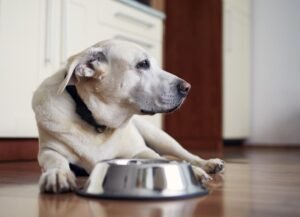Being a pet parent means being prepared for the unexpected. Sometimes issues come up at the most inconvenient times. While reaching out to your veterinarian for advice or an appointment is always recommended, there are some nonprescription therapies that are usually safe to try at home before you call or while you wait for an appointment.
8 Conditions That Can Benefit From Home Remedies for Dogs
1. Mild Diarrhea/Mucus in Stool
A short course of mild diarrhea doesn’t always mean a trip to the vet. Dogs with soft stool that are otherwise eating well and acting normally can be temporarily given a bland, easily digestible diet to allow the intestines some time to rest and heal from the inflammation causing the diarrhea. A bland diet at home is usually a combination of boiled chicken, turkey, or beef and rice. It is important not to roast or fry the meat, as the meat fat can cause pancreatitis.
A bland diet should not be fed for more than a week in adult dogs and two to three days in growing puppies. If your dog’s diarrhea is not decreasing during that time, a call to the vet is warranted to see if a prescription diet or probiotics may be needed. Dogs that have blood in the stool, decreased appetite, or vomiting should also be promptly evaluated by a veterinarian to ensure there isn’t a more serious cause.
2. Hot Spots
Hot spots are localized areas of inflammation in the skin that erupt suddenly and cause discomfort and frequent licking or scratching, which makes the lesion worse. Hot spots can be seen in any breed, but they are most common in dogs with thick coats like Golden Retrievers and German Shepherds. The most important thing to remember in treating a hot spot is keeping your dog from licking or scratching at it.
Elizabethan collars (e-collars) and loose T-shirts or shorts are highly effective at protecting these lesions as they heal. If you and your dog are comfortable with shaving the fur around the lesion with electric clippers (never scissors!) to get more air exposure, this can also help. Some dogs may be in too much pain to allow their pet parent to trim the hair. Severe hot spots (ones that don’t improve in 24–48 hours) may require oral antibiotics and anti-inflammatories from your vet. Never bandage a hot spot, as this will delay the healing process and can lead to further complications.
3. Itchy, Irritated, Dry Skin
There are many over-the-counter shampoos available for dogs with dry, itchy skin. Look for products that are oatmeal-based and fragrance-free for best results. If your dog’s itchy skin is more severe, your vet may recommend an antiseptic shampoo or mousse product with an ingredient like chlorhexidine.
Another way to tackle itchy, dry skin at home is by increasing the amount of omega-3 fatty acids in your dog’s diet. This is commonly done through food additives and supplements. You may also want to look into diets made for sensitive skin, as they often have a higher omega-3 free fatty acid (FFA) content.
4. Allergies
Our dogs are just as prone to having allergies as we are. Common symptoms in dogs are sneezing, a mild, clear eye discharge, and itching. Antihistamines like diphenhydramine and cetirizine are safe for dogs as long as they don’t contain any decongestants. Keep in mind that dosages are not the same for pets as for people! Your vet can guide you in the appropriate dosing of these products.
If yellow or green discharge is noted from your pet’s eyes or nose, if squinting is noted, or if there are any changes in your dog’s appetite or demeanor, antihistamines alone are unlikely to solve the issue. Call your vet for an appointment.
5. Licking Paws
Licking paws can be a normal behavior for most dogs, but excessive licking (leading to irritation and fur-color change) should be managed. More often than not, excessive foot licking is related to allergies or other contact-related irritants.
Epsom salt soaks of the feet for about 5–10 minutes at least once a day can help wash off environmental allergens and contaminants. This also soothes the skin of the feet and helps the healing process. Dogs with more severe inflammation may need to wear a recovery cone for a few days to prevent them from licking while the skin heals.
6. Ear Debris
Excess waxy debris in the ear that is not associated with severe itching or head shaking can often be managed at home with an ear cleaning, but it must be done very carefully. It is important to use a product designed for use in the ear canal. Household items such as vinegar, hydrogen peroxide, alcohol, and coconut oil should never be put in the ears, as they can cause more inflammation,
Appropriate products can either be poured directly into the canal or squeezed in using a soaked cotton ball. Massage the ear canal gently from the outside and mop up excess cleaner using your finger and a cotton ball before your dog shakes their head. Introducing objects into the canal such as cotton swabs is not necessary and can be dangerous. Swabs can puncture the tympanic membrane or break off deep in the canal. If your dog’s ears are very red and seem painful to them, a vet visit is recommended.
7. Fleas
With the many safe and effective flea-control products now available, at-home flea treatment is rarely needed. If you have a puppy that is too young or too small for approved products, original-scent Dawn® dish soap baths can be given to kill adult fleas immediately, but you’ll still need a medication to eliminate the problem. There are products approved for puppies as young as 6 weeks and as small as 2 pounds, so work with your veterinarian to determine the best medication.
8. Gas/Flatulence
Though some dogs may become gassy due to absorption issues and intestinal upset, gas in dogs is more frequently associated with lifestyle and diet. Dogs that gobble their food often swallow lots of air with it, which then passes through the digestive tract. Brachycephalic (short-nosed) dogs are also more prone to swallowing air due to the shape of their respiratory tract. These dogs may benefit from small, frequent meals or a slow-feeding bowl to reduce their flatulence.
Diet also plays an important role in how gassy a dog is. Make sure you are feeding your pet a high-quality diet. Some dogs may benefit from low-residue or easily digestible diets. If changing diet and feeding habits does not improve your dog’s flatulence, schedule a chat with your veterinarian.
13 Dog Health Issues That You Should NEVER Try Home Remedies For
Unfortunately, there aren’t home remedies for everything. If you notice any of the following issues in your dog, it’s best to treat them under the supervision of your veterinarian. Trying to manage them on your own can lead to delay of care and can sometimes make treatment more difficult.
1. Bad Breath
If good oral hygiene isn’t enough to keep your dog’s breath smelling sweet, it likely warrants an anesthetic dental procedure to appropriately diagnose and treat their periodontal disease.
2. Black or Bloody Stool
Though small amounts of bright-red blood can be seen in stool due to inflammation, your vet can do blood testing to make sure your dog doesn’t have a clotting issue or a severe form of gastroenteritis that may require hospitalization.
3. Bleeding Anus
Your vet can best assess where blood is coming from. A common cause of blood in the rectal area is an anal gland infection, which will require antibiotic therapy. In rare cases, there may be a surgical issue like a mass or trauma.
4. Bloated Stomach
If a bloated stomach manages to twist, it can be a life-threatening emergency. Your vet can take X-rays to determine the severity of the bloat and see if intervention is needed.
5. Blood in Urine/Bladder Infection
Infections are not the only cause of blood in the urine, and your vet can use a urinalysis to determine if antibiotics are necessary. X-rays may also be indicated to make sure that your dog doesn’t have bladder stones, which can cause very similar clinical signs.
6. Coughing/Wheezing
A cough that persists for more than a week or results in a dog not sleeping or eating well requires X-rays to help determine the cause. The treatments for pneumonia and heart failure are very different, yet the coughs typical in each condition can sound very similar.
7. Dermatitis/Mange/Ringworm
Dermatitis is an inflammatory condition that is usually much more uncomfortable than merely dry skin. Your vet will likely want to test to see if there is a bacterial or yeast infection and treat appropriately. This testing can also help rule out mites or mange, which may require a combination of topical and oral therapies. Ringworm may look very similar, and requires a separate test. Treatment for ringworm in dogs is very different from ringworm treatment for people.
8. Ear Mites
Mites are very uncommon in dogs and can often be treated with topical flea therapies. Most dogs presenting for ear mites have a yeast or bacterial otitis (ear infection). Your vet can make sure your dog’s ear canals are normal and prescribe appropriate antibiotics.
9. Eye Discharge, Red Eye, Pink Eye, or Cloudy Eye
Eye discharge may be the result of allergies, but it could also represent an ulcer, glaucoma, or internal eye inflammation called uveitis. These diseases can all cause your dog to lose their vision, so it is important to diagnose and treat them promptly.
10. Hair Loss
Hair loss without itching can be related to issues with your dog’s thyroid or adrenal glands, and should be evaluated.
11. Not Eating, Vomiting, Upset Stomach
While mild cases of upset stomach can be treated with diet change, vomiting or not eating can lead to dehydration and can indicate a more serious issue. Your vet can perform bloodwork and take X-rays to ensure your dog doesn’t have an intestinal blockage or another more serious condition that leads to these symptoms.
12. Pain
Though joint supplements available over the counter (such as glucosamine) can support your dog’s joint health, true pain (especially arthritis pain or other pain that causes limping) usually requires anti-inflammatory treatment. With some conditions, surgery may even be needed to make your dog feel well again. Never give your dog human medications or over-the-counter medications without first chatting with your veterinarian.
13. Worms
There are many over-the-counter dewormers available, but knowing what parasite needs to be treated (by letting your vet run a fecal sample) will help make sure the appropriate schedule is followed to eliminate that parasite. Some dewormers do not treat all worms, and others will only kill worms in a certain stage. Your vet can help navigate the therapy for faster resolution.
Featured Image: iStock/O_Lypa




